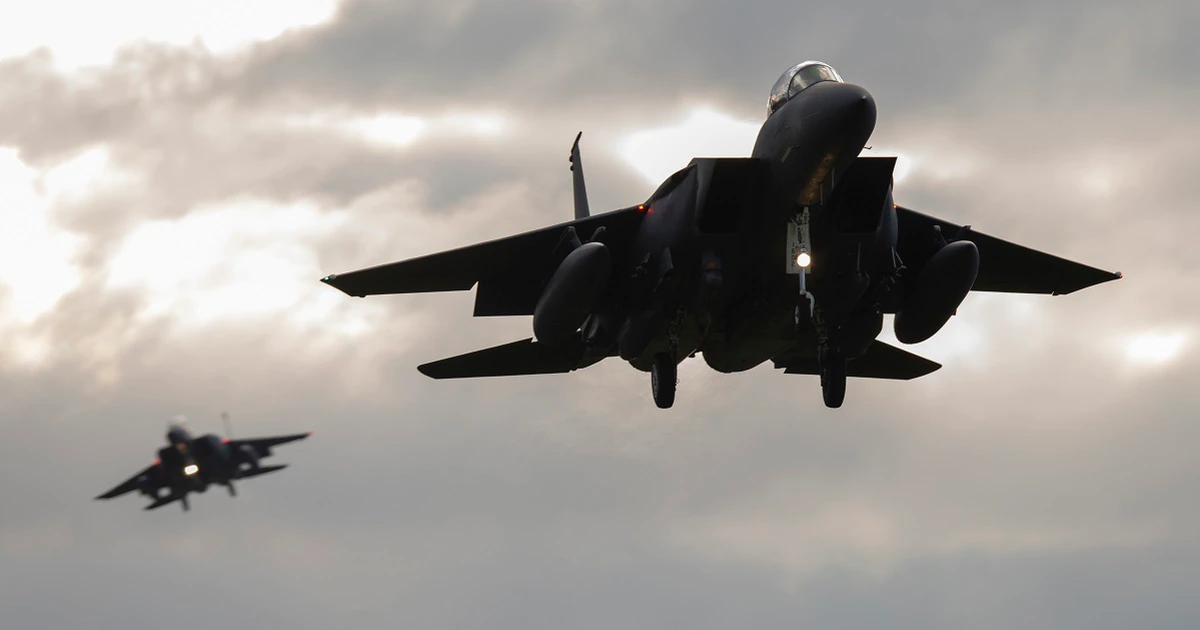
After three months of drone and rocket attacks on facilities in Iraq housing U.S. and coalition personnel, President Joe Biden ordered airstrikes Sunday on three Iran-backed militia facilities in Iraq and Syria.
“At President Biden’s direction, U.S. military forces earlier this evening conducted defensive precision airstrikes against facilities used by Iran-backed militia groups in the Iraq-Syria border region,” Pentagon spokesman John Kirby said in a statement. “The targets were selected because these facilities are utilized by Iran-backed militias that are engaged in unmanned aerial vehicle (UAV) attacks against U.S. personnel and facilities in Iraq.”
The U.S. strikes were carried out by F-15 and F-16 jets, a defense official told Military Times. They “targeted operational and weapons storage facilities at two locations in Syria and one location in Iraq,” both of which lie close to the border between those countries,” Kirby said. “Several Iran-backed militia groups, including Kata’ib Hezbollah (KH) and Kata’ib Sayyid al-Shuhada (KSS), used these facilities.”
The three targets were specifically associated with the militia drone threat — command, control and logistics — the defense official told Military Times.
The U.S. aircraft, which returned safely to their bases, used a mix of precision-guided munitions, a defense official told Military Times.
“It is too early to assess whether there were militia or civilian casualties,” the defense official said.
Earlier this month, the Baghdad Diplomatic Support Center was strike in a drone attack, Marine Gen. Kenneth F. McKenzie, commander of U.S. Central Command, confirmed to Military Times in an exclusive interview on June 11. A U.S. Embassy official said there were minor injuries of American personnel at the facility, which houses “several hundred US/Coalition servicemembers assigned there, Army Col. Wayne Marotto, a coalition spokesman, told Military Times earlier this month.
The diplomatic compound “suffered minor damage and a small number of personnel were treated and released for smoke inhalation,” a U.S. Embassy spokesperson told Military Times. he did not elaborate on whether those injured personnel were troops or civilians, nor weigh in on what types of munitions were used.
Sunday’s U.S. airstrikes were a response to ongoing Iran-backed militia drone and rocket attacks against U.S. and coalition personnel in Iraq, Navy Cmdr. Jessica McNulty, a Pentagon spokeswoman, told Military Times.
“Iran-backed militias have conducted at least five one-way UAV attacks against facilities used by U.S. and Coalition personnel in Iraq since April as well as ongoing rocket attacks against U.S. and Coalition forces,” she said.
The Sunday evening strike was at least the second time Biden has ordered retaliatory action against Iran-backed militias.
In February, a U.S. airstrike in Syria targeted facilities belonging to a powerful Iranian-backed Iraqi armed group, killing one fighter and wounding several others, an Iraqi militia official said at the time. That marked the first military action undertaken by Biden.
Pentagon officials said the February strikes were retaliation for attacks on U.S. interests in Iraq, including a rocket attack in northern Iraq on Feb. 15 that killed one civilian contractor and wounded a U.S. service member and other coalition troops.
At the time, Kirby, the Pentagon spokesman, said that two Air Force F-15E aircraft launched seven precision guided munitions, fully destroying nine facilities and heavily damaging two others, rendering the two “functionally destroyed.” He said the facilities, at “entry control points” on the border, had been used by militia groups the U.S. deems responsible for a number of recent attacks against U.S. interests in Iraq.
In his Sunday evening statement, Kirby said that the most recent U.S. airstrikes demonstrated that Biden “has been clear that he will act to protect U.S. personnel. Given the ongoing series of attacks by Iran-backed groups targeting U.S. interests in Iraq, the President directed further military action to disrupt and deter such attacks.”
In his June 11 interview with Military Times, McKenzie, the CENTCOM commander, confirmed that the attack on the BDSC was carried out by a drone and that it was representative of Iran’s actions in the region.
/arc-anglerfish-arc2-prod-mco.s3.amazonaws.com/public/622GZ7LTKBGBPL4GHNCRKR3IAU.jpg)
What war with Iran could look like
Military Times interviewed more than a dozen military experts, including current and former U.S. military officials, about how a conflict might begin and how it could play out. This is what they said could happen:
“These attacks are troubling, going forward, and what they represent is — for well over the last year, year and a half — Iran has sought to force us to leave Iraq,” McKenzie told Military Times, “And they sought to do that through political means. And so now that they recognize they’re not going to get there, politically, they’re shifting to a military approach, and that’s just where we are right now.
“The drone attack on the BDSC and this UAV attack — and I can tell you it was a UAV attack, but I’m really not in a position today to give you much more information on it right now — is representative of that.”
When asked if he anticipated the potential of kinetic action with Iran — in Iraq or elsewhere — McKenzie said that was a decision to be made at levels above him.
Sunday night, when asked if the U.S. military anticipates any retaliatory action from Iran, McNulty, the Pentagon spokesman, said that the most recent U.S. airstrikes “were necessary, appropriate, and deliberate action designed to limit the risk of escalation.
“Through these and other means, we seek to make clear to Iran and Iran-backed militia groups that there will be serious consequences if they continue to attack, or to arm, fund, and train militia groups that attack our people,” she said in an email statement to Military Times. “We will take necessary and appropriate measures to defend U.S. personnel, partners, and allies in the region.”



Be the first to comment